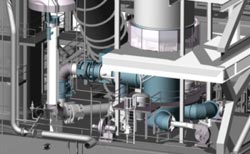More Flexibility for Steel Production

<br>
The newly developed JET Process provides sufficient heat energy to melt a high proportion of scrap and sponge iron into liquid pig iron. As a result, steel producers can more easily take advantage of low prices for these materials.
And because producing pig iron in a blast furnace creates especially large amounts of carbon dioxide, this new process also reduces CO2 emissions. This JET technology is already operating successfully in a steel mill in Asia.
The JET process uses a bottom-blowing converter. Such converters contain melted pig iron, scrap, and sponge iron. By blowing oxygen into this molten mass from below, these materials are processed into steel. Lime or other materials are introduced to promote the formation of slag. The amount of scrap and sponge iron in bottom-blowing converters may not exceed one fifth of the amount of pig iron. If this proportion were any larger, the scrap and sponge iron would no longer melt into the molten mass.
However, by injecting additional coal into the bottom of the converter, the JET process provides enough heat to enable a larger proportion of scrap and sponge iron to be added to the mixture. To achieve this result, a hot air lance blasts oxygen-enriched air at a temperature of around 1,300 °C onto the steel bath from above.
This hot blast travels at close to the speed of sound. It mixes the molten mass so completely that almost all of the carbon monoxide escaping from the bath reacts with the oxygen in the hot air blast, forming CO2 and heating the liquid steel. Additionally, coal is blown in from below, where it is used as fuel. This injection of coal is carefully controlled. The combination of a targeted introduction of coal and the hot air lance creates so much heat energy that the converter can be operated using only scrap and sponge iron. Moreover, due to their design, the oxygen jets located at the bottom of the converter slice through the scrap like cutting torches. As a result, the converter can be loaded with very large pieces of scrap.
These new special converters equipped with the JET process -make steel production less dependent on the availability of pig iron and allow more flexibility in blast furnace operations. With this innovation Siemens closes the gap between conventional converters, with their limits on the proportion of scrap and sponge iron they can accommodate, and electric-arc furnaces, which can only process steel scrap. JET technology can either be installed as a new facility or retrofitted into an existing plant.
Media Contact
More Information:
http://www.siemens.com/innovationnewsAll latest news from the category: Process Engineering
This special field revolves around processes for modifying material properties (milling, cooling), composition (filtration, distillation) and type (oxidation, hydration).
Valuable information is available on a broad range of technologies including material separation, laser processes, measuring techniques and robot engineering in addition to testing methods and coating and materials analysis processes.
Newest articles

Largest magnetic anisotropy of a molecule measured at BESSY II
At the Berlin synchrotron radiation source BESSY II, the largest magnetic anisotropy of a single molecule ever measured experimentally has been determined. The larger this anisotropy is, the better a…

Breaking boundaries: Researchers isolate quantum coherence in classical light systems
LSU quantum researchers uncover hidden quantum behaviors within classical light, which could make quantum technologies robust. Understanding the boundary between classical and quantum physics has long been a central question…

MRI-first strategy for prostate cancer detection proves to be safe
Active monitoring is a sufficiently safe option when prostate MRI findings are negative. There are several strategies for the early detection of prostate cancer. The first step is often a…



